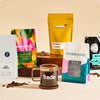We love our pour overs, various drip machines, and presses — both Aero and French. But sometimes you don’t have all the equipment you would need to make your recipe the way you want to, and sometimes you’re just bored and want to try something new.
When faced with the prospect of brewing coffee with limited tools, remember: the only things you absolutely need to make coffee is coffee, hot water, and a vessel. Everything else is just a matter of figuring out a recipe (and how much grinds you’re OK with having in your cup).
That's exactly what I asked myself the last time I was at my parents’ house. Despite having a perfectly decent coffee maker, they decided to make coffee the way they used to back in the day. This consisted of putting grinds in a cup and pouring hot water over them, then waiting until it’s cool enough to drink. After some light ribbing (they’re my parents, after all), I realized that I had never really considered that as a home brewing method.
That’s especially silly, as it’s basically the same thing I've been doing professionally for the past seven or eight years when cupping coffee. To evaluate coffees, coffee buyers, roasters, and indeed your friendly Trade QC team all measure out coffee in bowls and pour hot water onto it. We then wait until it cools and sip it with spoons. Drinking from special spoons might be a dealbreaker for home brewing, but everything else is still doable. So let’s try it out!
A Method for Equipment-Free Coffee Brewing
To start, I put 20 grams of medium-coarse coffee into a 12 ounce coffee mug. I brought some water to a boil, waited 20 seconds, and poured 320 grams of water onto it. After three minutes, I stirred just a little bit to break up the crust on the top. Then it was just a matter of waiting for the coffee to cool,
I let my cup sit on the counter and after a lucky 13 minutes, took a few sips off the top. It was totally fine, but maybe a smidge bitter — and I was pretty sure I knew why. When we’re cupping, we use bowls that hold less than 200 grams of water that are wider than they are tall. That combo of less mass and more exposure to air lets them cool faster than my mug. So, with a longer exposure to hot water, our grounds are extracting a little more of the bitter flavor compounds than we’d like.
The solution was pretty simple. For my next attempt, I used a little less water and threw ice cubes in the mug after five minutes of brewing. This lowered the temperature in the cup enough to slow down the extraction and stop that bitterness, plus it made the coffee drinkable sooner!
The coffee was nice and sweet — not overly bitter at all. If you like a full-bodied coffee, this method accomplishes that as well. Is it perfect? Not exactly. Once you get down to the last quarter of your cup, you get pretty close to those grounds lurking at the bottom. That means you have to sip pretty slowly to avoid a mouthful of grit. Like every coffee brewing method, this one has drawbacks and advantages, but it’s good to have a method in your back pocket that you can perform without any special coffee brewing equipment.
Instructions:
Put 20 grams (approximately 1.5 tbsp) of medium-coarse coffee in a 12 oz mug
Fill with 300 g of water (or just under-fill the mug)
After three minutes, stir the crust of grounds if one has formed on top of the brew
After five minutes, drop in two ice cubes
Drink when the coffee has cooled sufficiently
Pros
No special equipment needed, full body, easy to make taste good
Cons
Not the cleanest cup, mouth full of grinds if you’re not careful, could be easier to clean up
A Method for Low-Equipment Coffee Brewing
Mostly to help with cleanup, I decided to introduce a few pieces of equipment to my next brew: a mesh strainer and a bowl. Not only would this help separate the coffee from the grinds, but it would stop the brewing process, so no messing with ice cubes (though, if you just want your coffee ready to drink faster, using a little less water and then throwing in a few ice cubes still works).
This method is exceedingly simple, but I did still make one significant mistake that turned into a great lesson. An underrated advantage of dedicated coffee equipment is you don’t use it for other food. So while you should absolutely clean it, you don’t have to scrub as hard as, for example, a strainer that you’ve recently used to prep celery!
After that first vegetal cup, this method was pretty foolproof. And depending on how fine your mesh strainer is, it produces coffee that really isn’t that different from French press coffee. A tip for straining: use a spoon and get those bigger grind particles into your strainer instead of pouring slowly and keeping them in your mug. Those grounds will also help trap some of the finer grind particles that would easily slip through your strainer.
Instructions
- Put 20 g (approximately 1.5 tbsp) of medium-coarse coffee in a 12 oz mug
- Fill with 320 g of water (or basically all the way up)
- After 3 minutes, stir the crust of grounds if one has formed on top of the brew
- After 5 minutes, pour through a mesh strainer set over a bowl
- Pour liquid back into your mug and drink when cool enough
Pros
Very little special equipment needed, full body, easy to make taste good, easy cleanup
Cons
Still some fine grinds at the bottom of your cup, you must thoroughly clean your bowls and strainers before use
So, next time you’re taking a trip somewhere that might not have a perfect coffee brewing setup (or you just want to try something new), don’t fret. Are these brew methods perfect? Of course not. There are many good reasons — from ease of clean up to clearer flavors and increased control over fine details — that we use things like pour overs and gooseneck kettles. But then again, no brew method is truly perfect. And just because we can’t make a perfect cup of coffee, doesn’t mean we shouldn’t still make one that’s very good!









